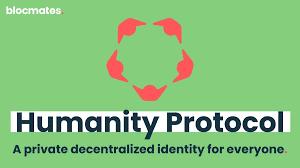- Humanity Protocol: The Future of Decentralized Identity Verification
- Introduction
- In today's digital world, identity verification is a critical yet flawed process. Traditional systems rely on centralized databases, exposing users to privacy breaches, identity theft, and censorship. Humanity Protocol emerges as a revolutionary decentralized identity (DID) solution built on blockchain technology, offering a secure, privacy-preserving, and user-controlled alternative.
This article explores:
What Humanity Protocol is and how it works
The problems it solves in digital identity management
Its unique Proof-of-Humanity (PoH) verification system
Key features and benefits
The $HUM token and ecosystem incentives
Real-world applications
Challenges and future potential
By the end, you'll understand why Humanity Protocol could redefine how we verify identity in Web3 and beyond.
What is Humanity Protocol?
Humanity Protocol is a decentralized identity verification network that uses blockchain and biometric authentication to distinguish real humans from bots and fake accounts. Unlike traditional KYC (Know Your Customer) systems, which store sensitive data in centralized servers, Humanity Protocol ensures self-sovereign identity—users own and control their credentials without relying on third parties.
Core Innovations
Proof-of-Humanity (PoH) Verification – Uses facial recognition and liveness detection to confirm unique human identity.
Zero-Knowledge Proofs (ZKPs) – Verifies identity without exposing personal data.
Decentralized Identifiers (DIDs) – Users manage their identity via blockchain wallets.
Sybil-Resistant Design – Prevents duplicate or fake identities.
Why Decentralized Identity Matters
Problems with Traditional Identity Systems
Privacy Risks – Centralized databases are hacking targets (e.g., Equifax breach).
Censorship – Governments or corporations can revoke access.
Exclusion – Millions lack formal ID, limiting financial access.
Bot Infestation – Fake accounts plague social media and DeFi.
How Humanity Protocol Solves These Issues
✅ Self-Custody – Users control their identity data.
✅ Interoperability – Works across Web3 apps, DeFi, and metaverses.
✅ Permissionless Access – No gatekeepers blocking verification.
✅ Anti-Sybil Mechanism – One human = one verified identity.
How Humanity Protocol Works
1. Identity Onboarding
Users download the Humanity app and complete a liveness check (e.g., facial scan).
Biometric data is encrypted and hashed (never stored raw).
A Decentralized Identifier (DID) is issued on-chain.
2. Proof-of-Humanity (PoH) Verification
Unlike CAPTCHAs (easily bypassed by bots), PoH requires biometric proof.
Verified users receive a soulbound NFT (non-transferable) as proof.
3. Using Your Humanity ID
Log into dApps without passwords.
Access DeFi protocols with lower fraud risk.
Prove uniqueness in DAO governance (1-person-1-vote).
Key Features & Benefits
Feature Benefit
Biometric Authentication Stops bots and Sybil attacks.
Zero-Knowledge Proofs Share credentials without exposing data.
Cross-Chain Compatibility Works on Ethereum, Polygon, Solana, etc.
Soulbound NFTs Non-transferable identity tokens.
DAO Governance Community controls protocol upgrades.
Advantages Over Competitors
BrightID – Relies on social graphs, not biometrics.
Worldcoin – Requires iris scans (privacy concerns).
ENS (Ethereum Name Service) – Doesn’t verify humanity.
The $HUM Token & Ecosystem
Token Utility
Governance – Vote on protocol upgrades.
Staking – Earn rewards for securing the network.
Fee Discounts – Pay less for verification services.
Token Distribution
Community Incentives (40%) – Rewards for early adopters.
Development (25%) – Funds core team and R&D.
Ecosystem Fund (20%) – Partnerships and grants.
Public Sale (15%) – Fair launch distribution.
Real-World Use Cases
1. DeFi & Anti-Sybil Measures
Prevents airdrop farming and ensures fair token distribution.
2. Social Media & Bot Prevention
Twitter/X could integrate Humanity Protocol to eliminate fake accounts.
3. DAOs & Democratic Voting
Enables 1-person-1-vote systems (e.g., for universal basic income projects).
4. Metaverse & Gaming
Stops multi-accounting in play-to-earn games.
5. Refugee & Borderless Finance
Provides digital IDs for the unbanked.
Challenges & Risks
Privacy Concerns – Biometric data must be securely handled.
Adoption Hurdles – Competing with entrenched KYC providers.
Regulatory Uncertainty – Governments may resist decentralized ID.
Centralization Risks – If the core team controls too much $HUM.
Future of Humanity Protocol
Potential developments include:
Integration with governments for digital passports.
AI resistance – Staying ahead of deepfake spoofing.
Expanding biometric options (voice, fingerprint).
Conclusion
Humanity Protocol is at the forefront of self-sovereign identity, offering a secure, scalable, and privacy-focused alternative to outdated KYC systems. By combining blockchain, biometrics, and ZKPs, it solves critical issues like Sybil attacks, financial exclusion, and data breaches.
As Web3 grows, decentralized identity will become the backbone of a trustless internet—and Humanity Protocol is leading the charge.
Final Thought
Will decentralized identity replace passports and driver’s licenses someday? With projects like Humanity Protocol, that future looks closer than ever.

